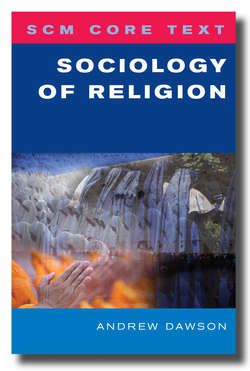Читать книгу SCM Core Text Sociology of Religion - Andrew Dawson - Страница 39
На сайте Литреса книга снята с продажи.
Macro-structural dimension
ОглавлениеAt its best, sociology explicates individual behaviour and institutional activity by conceptualizing their relationship with prevailing societal dynamics. Consequently, the raison d’être of the sociology of religion resides in its understanding the aforementioned dimensions of religion by examining their refraction of and influence upon prevailing social processes. As Maduro notes:
No religion exists in a vacuum. Every religion, any religion, no matter what we may understand by ‘religion’, is a situated reality – situated in a specific human context, a concrete and determined geographical space, historical moment, and social milieu. (1982, p. 41)
Sociology thereby engages the ‘situated reality’ of religion by identifying, exploring and seeking to explain its relationship with overarching societal structures and processes which both impact upon and are influenced by it.
In the first instance, sociology may concern itself with understanding the refraction of social and biological categories, such as class, race, age and sex, through the membership profiles of particular religious groups and movements. In Brazil, for example, census figures for male–female religious participation in Christianity are more or less equal for Roman Catholicism (49.5 per cent to 50.4 per cent respectively) and average out at approximately 44 per cent male to 56 per cent female for traditional Protestantism and most of neo-Pentecostalism. However, participation within the largest and fastest growing neo-Pentecostal group – the Universal Church of the Kingdom of God – exhibits a distinctly asymmetrical profile with 38 per cent male to 62 per cent female involvement. At the same time, there is also a clear asymmetry among those recorded by the census as ‘without religion’ (60 per cent male to 40 per cent female) (Campos, 2004, p. 134). In the same vein, new and alternative spiritualities across the industrialized world draw the bulk of their members from the white, urban middle classes and exhibit a greater ratio of female to male participation (Clarke, 2005). What do these figures tell us about society in general and the religious arena in particular – not least its reproduction of or challenge to prevailing class, ethnic-racial and gendering dynamics?
Secondly, for example, the sociology of religion may concern itself with the interaction between religious institutions and prevailing political, economic and legal structures. On the one hand, sociology can engage the ways in which different religious groups are more or less efficient in accessing the mechanisms of political power and thereby gaining financial or juridical privileges through, for example, tax breaks (as charities) or legal protections (via blasphemy laws) and exemptions (equality laws). On the other hand, sociologists might also analyse the manner in which different political, economic and legal structures work to the benefit of some forms of religion (usually mainstream traditional) and to the detriment of others (usually novel religious phenomena). Understanding both the religious interface with existing opportunity structures and the ways in which these structures shape the religious landscape is a central concern of much contemporary sociology of religion.
A third example can be drawn from sociology’s attempts to understand the implications of modernity for religious belief and practice. For example, each of the characteristics of modern society mentioned in the previous chapter (e.g. integration, complexity, individualization) generates both challenges to and opportunities for the religious field. For some sociologists, such are the challenges which modernity sets religion that religious decline, if not eventual disappearance, is their rather pessimistic prognosis (Bruce, 2002). For others, however, while the challenges which modernity sets religion may well result in decline in certain (usually traditional) sectors, in other areas modernity is seen to furnish ample opportunity for religious transformation and growth (Martin, 2005). Wherever one stands in respect of growth, decline and/or transformation, the attempt to relate macro-structural processes with micro-social and mid-range institutional activity sits at the heart of sociology’s engagement with religion. After all, it is through the interplay of these dynamics that the different dimensions of religion assume in real time and space their multifarious shapes, rhythms, smells and colours.
